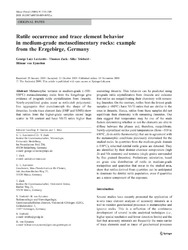Rutile occurrence and trace element behavior in medium-grade metasedimentary rocks: example from the Erzgebirge, Germany
Luvizotto, George Luiz
Zack, Thomas
Triebold, Silke
von Eynatten, Hilmar
97, 3-4: 233 - 249
DOI: https://doi.org/10.1007/s00710-009-0092-z
Persistent URL: http://resolver.sub.uni-goettingen.de/purl?gldocs-11858/6894
Persistent URL: http://resolver.sub.uni-goettingen.de/purl?gldocs-11858/6894
Luvizotto, George Luiz; Zack, Thomas; Triebold, Silke; von Eynatten, Hilmar, 2009: Rutile occurrence and trace element behavior in medium-grade metasedimentary rocks: example from the Erzgebirge, Germany. In: Mineralogy and Petrology, Band 97, 3-4: 233 - 249, DOI: 10.1007/s00710-009-0092-z.
 |
Dokument öffnen: |
Metamorphic textures in medium-grade (~500–
550°C) metasedimentary rocks from the Erzgebirge give
evidence of prograde rutile crystallization from ilmenite.
Newly-crystallized grains occur as rutile-rich polycrystalline
aggregates that pseudomorph the shape of the
ilmenites. In-situ trace element data (EMP and SIMS) show
that rutiles from the higher-grade samples record large
scatter in Nb content and have Nb/Ti ratios higher than
coexisting ilmenite. This behavior can be predicted using
prograde rutile crystallization from ilmenite and indicates
that rutiles are reequilibrating their chemistry with remaining
ilmenites. On the contrary, rutiles from the lowest grade
samples (~480°C) have Nb/Ti ratios that are similar to the
ones in ilmenite. Hence, rutiles from these samples did not
equilibrate their chemistry with remaining ilmenites. Our
data suggest that temperature may be one of the main
factors determining whether or not the elements are able to
diffuse between the phases and, therefore, reequilibrate.
Newly-crystallized rutiles yield temperatures (from ~500 to
630°C, Zr-in-rutile thermometry) that are in agreement with
the metamorphic conditions previously determined for the
studied rocks. In quartzites from the medium-grade domain
(~530°C), inherited detrital rutile grains are detected. They
are identified by their distinct chemical composition (high
Zr and Nb contents) and textures (single grains surrounded
by fine grained ilmenites). Preliminary calculation, based
on grain size distribution of rutile in medium-grade
metapelites and quartzites that occur in the studied area,
show that rutiles derived from quartzites can be anticipated
to dominate the detrital rutile population, even if quartzites
are a minor component of the exposure.
Statistik:
ZugriffsstatistikSammlung:
- Geologie [931]

